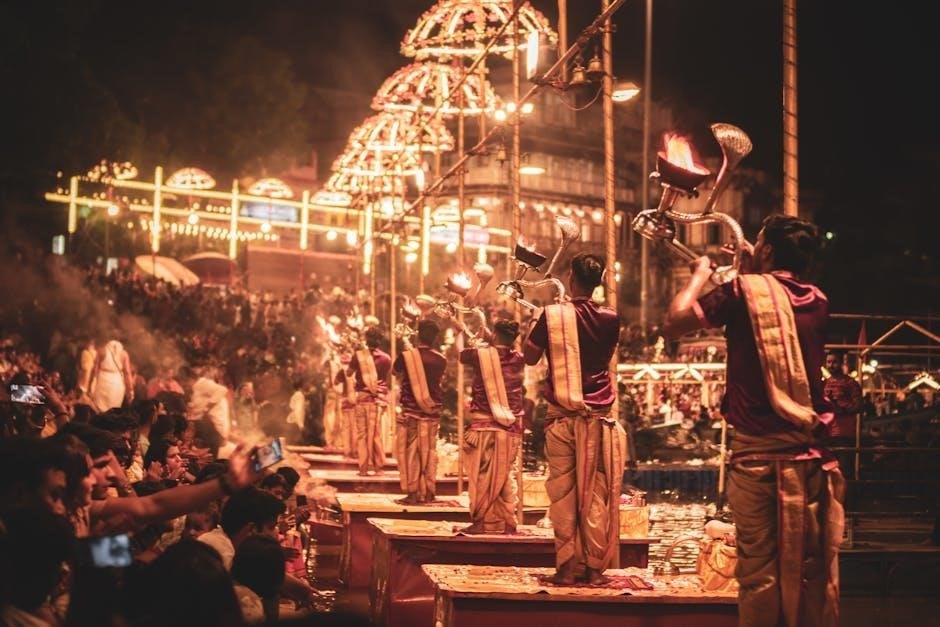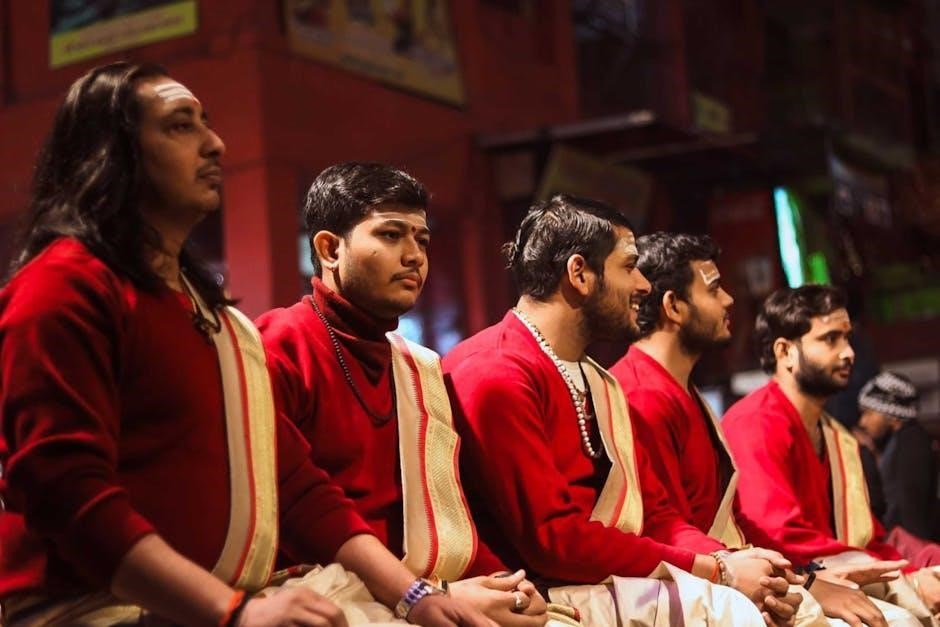
Article Plan: Shivji Aarti PDF
This article details the Shivji Aarti, exploring its lyrics (Hindi & English), benefits, rituals, and online PDF resources. It covers variations like Kailashvasi & Shankar Aarti, and Anuradha Paudwal’s recitations.
Shiv Aarti, a devotional hymn dedicated to Lord Shiva, holds a prominent place in Hindu worship. Specifically, “Om Jai Shiv Omkara” is arguably the most recognized and frequently recited aarti honoring the deity. The practice involves singing praises while performing a ritualistic circling of a lit lamp before an image or symbol of Shiva.
This aarti isn’t merely a song; it’s a powerful expression of devotion, a way to connect with the divine energy of Lord Shiva. PDF versions of the lyrics are widely sought after for personal practice and religious ceremonies. The accessibility of these PDFs, as highlighted by sources like Times Now and My Pooja Box India, demonstrates the widespread reverence for this particular aarti.
Furthermore, resources like YouTube provide full video recitations, notably by Anuradha Paudwal, enhancing the experience for devotees.
The Significance of Aarti in Hinduism
Aarti, within Hinduism, transcends a simple song; it’s a sacred ritual symbolizing the offering of light to the divine. This practice represents dispelling darkness – ignorance – and welcoming enlightenment. It’s a core element of puja (worship), fostering a deep connection between the devotee and the deity.
The waving of a lit lamp, often accompanied by incense and flowers, during the singing of the aarti, is believed to purify the atmosphere and invoke blessings. Shiv Aarti, specifically, glorifies Lord Shiva’s attributes and power.
The increasing availability of Shiv Aarti PDFs, as noted by various online sources, reflects a growing desire for accessible devotional practices. This allows individuals to easily incorporate this powerful ritual into their daily spiritual routines, deepening their faith and devotion. It’s a lyrical composition of grace and might.
Lord Shiva: A Brief Overview
Lord Shiva is one of the principal deities of Hinduism, revered as the Destroyer and Transformer. He embodies both creation and destruction, representing the cyclical nature of existence. Often depicted as an ascetic, meditating on Mount Kailash, Shiva is a complex figure with diverse iconography.
He is commonly portrayed with a third eye, symbolizing wisdom and insight, and adorned with a crescent moon, representing control over time. Shiv Aarti is dedicated to praising these aspects of the Lord. The accessibility of Shiv Aarti PDFs demonstrates the widespread devotion to this powerful deity.

Understanding Shiva’s multifaceted nature is crucial when engaging with the aarti. His presence is felt through devotion and the recitation of sacred hymns.
Shiva’s Benevolent Aspects
Lord Shiva’s benevolent side manifests as a compassionate protector and a source of grace. He is often depicted as a Yogi, embodying peace and tranquility, residing on Mount Kailash with his consort, Parvati. This aspect emphasizes his role as a benefactor, granting blessings and fulfilling desires.
The Shiv Aarti frequently highlights these qualities, praising Shiva’s kindness and generosity. PDF resources containing the lyrics allow devotees to connect with this nurturing side of the deity. His association with the Ganges River, purifying and life-giving, further illustrates his benevolent nature.
Reciting the aarti is believed to invoke these positive energies, fostering spiritual well-being and inner peace.
Shiva’s Fearsome Aspects
Alongside his benevolent nature, Lord Shiva embodies a fearsome, destructive power essential for cosmic balance. This aspect, often visualized through depictions like Nataraja – the cosmic dancer – represents the dissolution of ignorance and illusion. He is capable of immense wrath when dharma is threatened, a force that eradicates negativity.
While the Shiv Aarti primarily focuses on praise, acknowledging this power is crucial. PDF versions of the lyrics don’t shy away from recognizing Shiva’s strength. His multiple arms and fierce iconography symbolize his ability to overcome obstacles and vanquish evil.
Understanding this duality is key to a complete devotion, appreciating both Shiva’s grace and his formidable power.
Om Jai Shiv Omkara: The Most Popular Shiv Aarti
“Om Jai Shiv Omkara” reigns supreme as the most widely recognized and beloved Shiv Aarti. Its melodic rhythm and powerful verses resonate deeply with devotees, making it a staple in Hindu worship. Numerous Shiv Aarti PDF resources online feature this aarti prominently, often as the first and most detailed offering.
The aarti’s popularity stems from its accessibility and profound spiritual message. It glorifies Lord Shiva’s various forms and attributes, invoking his blessings for peace, prosperity, and liberation. Anuradha Paudwal’s rendition has further amplified its reach, becoming synonymous with the aarti itself.
Finding a PDF version allows for easy access to the lyrics for personal practice and devotional singing.
Lyrics of Om Jai Shiv Omkara Aarti (Hindi)
Here are the lyrics to the revered “Om Jai Shiv Omkara” Aarti in Hindi, frequently found within Shiv Aarti PDF documents. This version is widely used during devotional practices and is readily available online for those seeking to deepen their connection with Lord Shiva.
Om Jai Shiv Omkara, Swami Jai Shiva Omkara
Bramha Vishnu Sadashiv Ardhangi Dhaara II
Om jai shiv omkara II
Ekaanan chaturaanan panchaanan raje
Hansaasan garudaasan vrishvaahan saaje II
Om jai shiv omkara II
Do Bhuj Chaaru Chaturbhuj Dasbhuj
Trinetra Vajra Dhaara Trishul Haste II
These lyrics, often presented in clear formatting within PDF versions, facilitate accurate recitation and understanding of this powerful hymn.
Lyrics of Om Jai Shiv Omkara Aarti (English Translation)
Below is the English translation of the popular “Om Jai Shiv Omkara” Aarti, commonly included in Shiv Aarti PDF resources. This translation allows devotees who are not fluent in Hindi to fully appreciate the devotional meaning and power of the hymn. Accessing these PDF versions provides both the original lyrics and their English counterparts.
Om Jai Shiv Omkara, O Lord Shiva, Omkara
Brahma, Vishnu, and Sadashiva, the support of Ardhangini (Parvati)
Om Jai Shiv Omkara II
With one face, four faces, and five faces, you are the king
Seated on a swan, Garuda, and a bull, you are magnificently adorned II
Om Jai Shiv Omkara II
With two arms, four arms, and ten arms…
These translations, found in many Shiv Aarti PDFs, enhance understanding and facilitate heartfelt devotion.
Meaning and Interpretation of the Aarti Lyrics
The “Om Jai Shiv Omkara” Aarti, readily available in Shiv Aarti PDF formats, isn’t merely a song; it’s a profound expression of devotion. The lyrics celebrate Lord Shiva’s multifaceted nature, acknowledging Brahma, Vishnu, and Sadashiva as integral parts of the divine. PDF resources often include interpretations explaining the symbolism.
The references to multiple faces and arms represent Shiva’s immense power and ability to manifest in various forms. The imagery of different vahans (mounts) – swan, Garuda, bull – signifies his control over diverse energies. Understanding these symbols, as detailed in Shiv Aarti PDF guides, deepens the spiritual experience.
The Aarti’s essence lies in recognizing Shiva as the ultimate reality.
Understanding the Deities Mentioned
Within the Shiv Aarti PDF lyrics of “Om Jai Shiv Omkara,” several deities are invoked, enriching the hymn’s spiritual depth. The mention of Brahma, Vishnu, and Sadashiva establishes Shiva as the supreme being, encompassing the Hindu trinity. PDF resources often elaborate on this concept, explaining their interconnectedness.
Parvati, Shiva’s consort, is honored as his eternal partner, representing shakti (divine feminine energy). Nandi, the bull, symbolizes devotion and righteousness, while Bhringi, a devotee, embodies unwavering faith. Shiv Aarti PDF materials clarify these roles.

These deities aren’t separate entities but facets of the same divine consciousness, celebrated within the Aarti’s verses.
Symbolism within the Lyrics
The Shiv Aarti PDF reveals rich symbolism within its verses. Shiva’s multiple arms (Chaturbhuj, Dasbhuj) represent his immense power and ability to simultaneously perform various cosmic functions. PDF analyses highlight this. His mounts – Hansa (swan), Garuda, and Vrishvaahan (bull) – symbolize different paths to liberation.
The lyrics referencing “Ekaanan chaturaanan panchaanan raje” depict Shiva in various forms, representing his all-pervading nature; Shiv Aarti PDF resources explain these forms as manifestations of his divine energy. The Shisha Ganga symbolizes purity and spiritual cleansing.
Ultimately, the symbolism points towards Shiva’s transcendence and the devotee’s journey towards self-realization.
Benefits of Reciting Shiv Aarti
According to Shiv Aarti PDF resources, regular recitation offers numerous spiritual and worldly benefits. Devotees believe it fosters peace, removes negative energies, and protects against misfortune. The Shiv Aarti PDF often details how it aids in overcoming obstacles and achieving success in endeavors.

PDF guides suggest reciting the Aarti enhances devotion, strengthens faith, and deepens the connection with Lord Shiva. It’s believed to purify the mind, body, and soul, leading to inner tranquility. Shiv Aarti PDF materials also mention benefits like improved health and prosperity.

Ultimately, consistent practice cultivates a positive aura and spiritual growth.
When to Recite Shiv Aarti
Shiv Aarti PDF guides suggest several auspicious times for recitation. Many devotees perform the Aarti daily, preferably during sunrise or sunset, considered powerful times for spiritual practice. According to Shiv Aarti PDF resources, Mondays – sacred to Lord Shiva – are particularly favorable.
The Shiv Aarti PDF often recommends reciting during the Pradosh period (twilight hours) and on special occasions like Mahashivratri. Recitation during festivals dedicated to Lord Shiva is also highly beneficial. Some devotees incorporate it into their daily puja routine.
Ultimately, the most important time is when one feels a sincere connection and devotion to Lord Shiva.
How to Perform Shiv Aarti
According to Shiv Aarti PDF guides, performing the Aarti involves specific steps. First, cleanse the space and yourself. Then, arrange essential items – a Shiv Aarti PDF often lists a diya (oil lamp), incense, flowers, water, and a plate for offerings.
Begin by invoking Lord Shiva with a prayer. Light the diya and wave it in a circular motion before the deity while chanting the Aarti lyrics. Offer flowers, water, and incense. The Shiv Aarti PDF emphasizes sincere devotion during the ritual.
Finally, distribute the prasad (offered food) among devotees. Maintaining a peaceful and focused mind is crucial throughout the process.
Essential Items for Aarti
As detailed in many Shiv Aarti PDF resources, preparing for the ritual requires specific items. A diya (oil lamp) is fundamental, symbolizing the dispelling of darkness. Incense sticks create a fragrant, spiritual atmosphere. Fresh flowers, particularly bel (bilva) leaves, are highly auspicious for Lord Shiva.
A small container of water, often in a copper vessel, is used for ritual purification. A plate or thali holds the Aarti offerings – flowers, incense, and sometimes sweets. Shiv Aarti PDF guides also suggest a clean cloth and a comfortable seating arrangement.
Some devotees include rooli (red vermillion powder) and akshat (unbroken rice) for added sanctity.

The Aarti Ritual Step-by-Step
Following a Shiv Aarti PDF guide, begin by cleansing the space and yourself. Seat yourself facing an image or symbol of Lord Shiva. Light the diya and incense. Offer flowers and water to the deity. Begin chanting the Om Jai Shiv Omkara Aarti, circulating the diya clockwise in front of the deity.

Maintain a devotional mindset throughout. As the Aarti progresses, visualize Lord Shiva’s presence. Shiv Aarti PDF resources emphasize sincerity over perfection. After completing the Aarti, offer the prasad (sweet offering) to all present.
Conclude with a moment of silent prayer and gratitude.
Shiv Aarti and its Connection to Mount Kailash

Mount Kailash, Lord Shiva’s divine abode, holds immense significance in Shiv Aarti practice. Many Shiv Aarti PDF resources highlight Kailash as the ultimate source of spiritual energy. Reciting the Aarti while visualizing Mount Kailash deepens devotion and fosters a connection with the divine.
The Kailashvasi Aarti specifically invokes the blessings of Shiva residing on Kailash. Shiv Aarti PDF guides often suggest meditating on the mountain’s majestic beauty during recitation. This practice is believed to purify the mind and accelerate spiritual progress.

Kailash represents transcendence and liberation, mirroring the transformative power of the Aarti itself.
Different Types of Shiv Aartis
Numerous Shiv Aartis exist, each with unique lyrical compositions and devotional focuses. Shiv Aarti PDF collections commonly include Om Jai Shiv Omkara, the most widely recognized. Another prominent form is Kailashvasi Aarti, specifically invoking Shiva’s presence on Mount Kailash, often found within Shiv Aarti PDF downloads.
Shankar Aarti is also frequently featured, praising Shiva’s benevolent and powerful aspects. These variations cater to diverse devotional preferences. Shiv Aarti PDF resources often provide comparative analyses of these Aartis.
Understanding these differences enriches the devotional experience and allows practitioners to choose an Aarti resonating with their spiritual needs.
Kailashvasi Aarti
The Kailashvasi Aarti specifically venerates Lord Shiva residing on Mount Kailash, his divine abode. Shiv Aarti PDF resources frequently include this Aarti due to its powerful imagery and devotional significance. Lyrics often depict Shiva with Parvati, surrounded by devotees like Nandi and Bhringi, engaged in eternal worship.
This Aarti emphasizes Shiva’s serene and majestic presence on the sacred mountain. Shiv Aarti PDF versions often include transliterations and translations, aiding comprehension. Reciting the Kailashvasi Aarti is believed to invoke blessings of peace, strength, and spiritual elevation.
It’s a potent practice for those seeking connection with Shiva’s divine energy and the sanctity of Mount Kailash.
Shankar Aarti
The Shankar Aarti is another prominent devotional hymn dedicated to Lord Shiva, frequently found within Shiv Aarti PDF collections. It glorifies Shiva as the benevolent and powerful deity, highlighting his various attributes and divine forms. Shiv Aarti PDF resources often present this Aarti alongside the more popular Om Jai Shiv Omkara.
Lyrics typically praise Shiva’s role as the destroyer of evil and the bestower of blessings. Recitation of the Shankar Aarti is believed to purify the mind, remove obstacles, and foster spiritual growth. Many Shiv Aarti PDF downloads include detailed explanations of the verses.
It’s a cherished practice for devotees seeking Shiva’s grace and protection.
Shiv Aarti Recitations by Anuradha Paudwal
Anuradha Paudwal is a highly revered name in devotional music, and her renditions of Shiv Aarti are exceptionally popular. Many Shiv Aarti PDF resources link to or mention her recordings, recognizing their widespread appeal and devotional quality. Her full video song of Shiv Aarti, available on platforms like YouTube, is a frequently shared resource.
Paudwal’s voice is considered deeply resonant and spiritually uplifting, enhancing the emotional impact of the Aarti. Shiv Aarti PDF websites often feature links to her music, allowing devotees to easily access and listen while following the lyrics. Her Sampoorna Aartiyan compilation includes various Aartis, including the Shiv Aarti;
Devotees often seek her recordings for a more immersive and devotional experience.
Finding Shiv Aarti PDF Resources Online
Numerous websites offer Shiv Aarti PDF downloads, catering to devotees seeking convenient access to the lyrics. Times Now and My Pooja Box India are prominent examples, providing both Hindi and English translations. A simple online search for “Shiv Aarti PDF” yields a wealth of results, including options for various Aarti variations.
These PDFs typically include the Aarti lyrics, along with transliterations and meanings, aiding in understanding and recitation. Many resources also offer accompanying audio or video links, such as those featuring Anuradha Paudwal’s renditions. Be cautious when downloading from unfamiliar sources, ensuring the site is reputable.
Devotees can easily print or view these PDFs for personal use during Aarti rituals.
Shiv Aarti and Spiritual Well-being
Reciting Shiv Aarti is believed to foster profound spiritual well-being. The devotional lyrics and rhythmic melodies create a conducive atmosphere for connecting with Lord Shiva, promoting inner peace and tranquility. Regular practice is thought to purify the mind, reduce stress, and enhance concentration.
The Aarti’s powerful vibrations are said to dispel negative energies and create a positive aura. Devotees often experience a sense of calmness and emotional balance after engaging in this practice. Furthermore, the act of devotion itself cultivates gratitude and strengthens one’s faith.
Ultimately, Shiv Aarti serves as a potent tool for spiritual growth and self-realization, fostering a deeper connection with the divine.
The Role of Music in Shiv Aarti
Music is integral to the Shiv Aarti experience, elevating the devotional atmosphere and enhancing its spiritual impact. The rhythmic beats of the drums, the resonance of the bells, and the melodic chanting create a captivating soundscape. Anuradha Paudwal’s renditions, widely available online, exemplify this beautifully.
The specific ragas and musical arrangements used in Shiv Aarti are carefully chosen to invoke a sense of reverence and devotion. The vibrations produced by the music are believed to resonate with the divine energies of Lord Shiva, facilitating a deeper connection.
Ultimately, music transforms the Aarti from a simple recitation into a powerful and immersive spiritual practice.
Aarti vs. Mantra: Understanding the Difference
While both Aarti and Mantra are vital Hindu devotional practices, they differ in their approach and purpose. A Mantra is a sacred sound, syllable, or phrase repeated to focus the mind and achieve spiritual realization. It’s often a personal, internal practice.
Conversely, an Aarti is a lyrical composition glorifying a deity, performed with rituals like waving lamps and incense. It’s typically a communal, external expression of devotion, involving singing and offering light. Shiv Aarti, like “Om Jai Shiv Omkara,” falls into this category.
Essentially, a Mantra is about internalizing divine energy, while an Aarti is about offering reverence and connecting with the deity through external worship.
Shiv Aarti and Festivals
Shiv Aarti holds a prominent place in numerous Hindu festivals dedicated to Lord Shiva, enhancing the devotional atmosphere. During Maha Shivaratri, reciting the Aarti is a central practice, often performed throughout the night alongside fasting and prayers.
Similarly, during festivals like Shravan Maas (the holy month dedicated to Shiva), and on auspicious days like Pradosham, the Shiv Aarti is frequently chanted in temples and homes. It’s also common during special pujas and ceremonies honoring Lord Shiva.
The rhythmic melodies and devotional lyrics of the Aarti amplify the festive spirit, fostering a deeper connection with the divine.
Common Misconceptions about Shiv Aarti
A frequent misconception is that Shiv Aarti is solely for ascetics or those deeply versed in spiritual practice. However, the Aarti is accessible to everyone, regardless of their background or level of devotion. Another belief is that specific rituals must be followed precisely for the Aarti to be effective; while proper procedure is respectful, sincere devotion is paramount.
Some believe the Aarti is merely a song, overlooking its deeper symbolic meaning and the power of focused intention during recitation. It’s also incorrectly assumed that only priests can perform the Aarti correctly; individuals can perform it at home with reverence.
Ultimately, the essence of Shiv Aarti lies in heartfelt devotion, not rigid adherence to rules.
The Power of Devotion through Shiv Aarti
Shiv Aarti transcends a simple devotional song; it’s a powerful conduit for connecting with the divine energy of Lord Shiva. Through sincere recitation, individuals can experience profound spiritual benefits, including peace, clarity, and protection. The accessibility of Shiv Aarti PDFs further democratizes this practice, allowing anyone to incorporate it into their daily life.

Whether performed elaborately or simply, the core of the Aarti lies in unwavering devotion. The lyrics, rich in symbolism, offer a pathway to understanding Shiva’s multifaceted nature. Ultimately, the power of Shiv Aarti resides not in the ritual itself, but in the heartfelt offering of one’s devotion.




No comment yet, add your voice below!